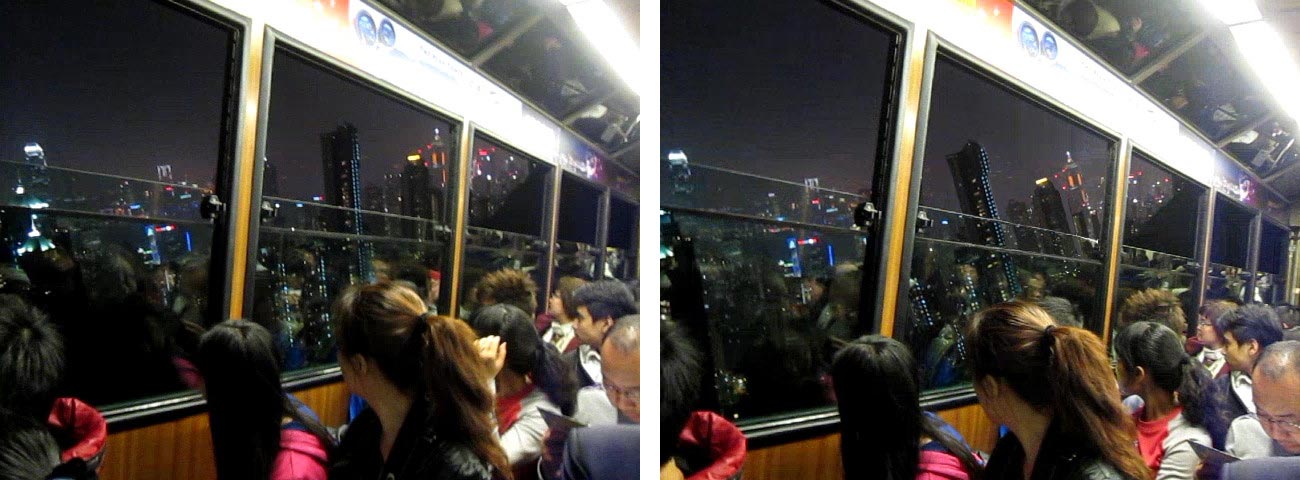Why Hong Kong Skyscrapers Look Like They're Falling

The illusion of toppling skyscrapers in Hong Kong is now yielding insights on how the brain distinguishes up from down, researchers say.
A popular way to gaze at the Hong Kong skyline that millions of people take advantage of every year is to ride a tram there up Victoria Peak, the highest mountain on Hong Kong Island.
"On one trip, I noticed that the city's skyscrapers next to the tram started to appear very tilted, as if they were falling, which anyone with common sense knows is impossible," said lead researcher Chia-huei Tseng, a cognitive psychologist at the University of Hong Kong. "The gasps of the other passengers told me I wasn't the only one seeing it."
The skyscrapers appear to fall away from passengers, toward the peak of the mountain, where the tram goes, Tseng explained. [Infographic: The World's Tallest Buildings]
"When the tram rides to the peak, I sometimes feel I am traveling through a group of Leaning Towers of Pisa, except these buildings are easily 20 to 30 floors tall, and they appear to lean much more, a maximum of 30 degrees, than the Leaning Tower of Pisa, which leans 4 to 5.5 degrees," she told LiveScience.
The illusion persists, "even after I told myself it couldn't be true," Tseng said. "Even after two years of riding up and down, accumulating more than 200 trips, it's still as strong as the first time I saw it."
Vertical illusion
Sign up for the Live Science daily newsletter now
Get the world’s most fascinating discoveries delivered straight to your inbox.
The human brain usually excels at perceiving verticality — at telling up from down.
"The best example is when we wake up in bed," Tseng said. "Everything we see from our eyes is 90 degrees from when we see it at an upright standing posture. However, we don't feel the world flip by 90 degrees."
People rely on at least four different sensory systems to perceive verticality. In addition to visual cues, the brain also tells up from down using cues from touch, as well as from the vestibular system based in the inner ear, which uses tubes of fluid to reveal how the body is positioned, and the proprioceptive system, which perceives the location of each part of the body and how much effort they need to move.
This means even when looking at the world while lying flat, "our brain knows our bodies are lying down flat," Tseng said. As such, the brain adjusts the image the eye perceives.
Strangely, the Hong Kong illusion persists even though people have complete access to visual cues from the outside world via through the open windows of the tram. Similar visual illusions researchers study in the laboratory often fail when people can see more than one sign of where up and down really are. [Images: The Most Amazing Optical Illusions]
To uncover the origins of this illusion, Tseng and her colleagues explored it under a variety of conditions. They found the perceived tilt was greatest on nighttime rides, perhaps due to a dearth of visual cues of verticality. In addition, they discovered the illusion was significantly reduced when passengers stood up, which reinforced the feeling of gravity's pull.
Obscuring the window frames of the tram also helped to significantly lessen the illusion. As the tram tilts as it heads uphill, the straight lines of its window frames and other features make the vertical lines of the skyscrapers appear tilted.
Why the illusion persists
However, no single adjustment the researchers carried out was enough to eliminate the illusion.
"Our experiences and our learned knowledge about the world — that buildings should be vertical — are not enough to cancel our brain's wrong conclusion," Tseng said.
The combination of motion, slope and the view seen from the tram apparently lead to a scenario where "our brains are unable to give a reliable answer," Tseng said.
Lab studies of how people detect verticality usually look at how the systems that determine verticality work separately, not together. These new findings suggest all the senses need to work together in order to abolish the illusion.
"This tilt illusion is a demonstration of the limitation our brain has to represent verticality accurately," Tseng said.
Future research could try experimentally recreating the illusion in the lab. For instance, the researchers have borrowed a dental chair from the University of Hong Kong's dental school that allows them to seat people at similar tilts to ones experienced while sitting in the tram. "We use this to understand whether our vertical sense is similarly distorted with similar body tilts without motion," Tseng said.
The scientists would also like to work with driving simulators that can create similar motions, speed and tilts as in the tram. "This is our best hope to better understand how our brains compute verticality," Tseng said.
"Personally, this is the most romantic psychology experiment I have ever attempted," Tseng said. "If you are ever in Hong Kong, make sure you have Victoria Peak in your visit plan."
Tseng and her colleagues Hiu Mei Chow and Lothar Spillmann detailed their findings in the June issue of the journal Psychological Science.
- Optical Illusions: A Gallery of Visual Tricks
- 10 Things You Didn't Know About the Brain
- Seeing Things On Mars: A History of Martian Illusions
Follow us @livescience, Facebook & Google+. Original article on LiveScience.com.

Why is yawning contagious?
Scientific consensus shows race is a human invention, not biological reality









